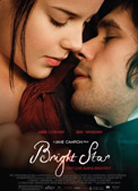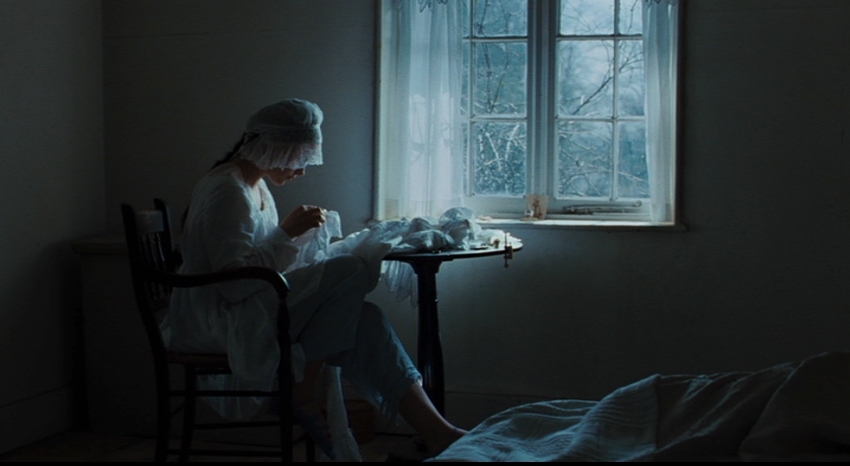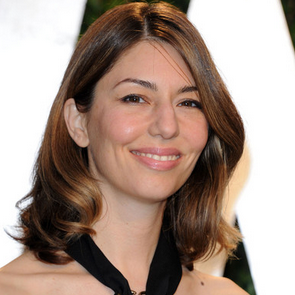Have you participated in Hit Me With Your Best Shot? Visual index coming tonight!
 As an end to this month-long series on Jane Campion, Bright Star presents a perfect kind of artistic summation for the writer/director. This John Keats romance is part of a tradition of filmmakers and playwrights making art about art. Though presumably about the life of an artist, the finished play or film acts as its creator’s thesis statement about sublime inspiration (Minnelli’s Lust for Life), beauty and pain (Julie Taymor’s Frida), the thin line between madness and creation (Scorsese's The Aviator), or the creative process (Sondheim’s Sunday in the Park with George). Inevitably, these films and plays are as much about their creators as they are about their subjects.
As an end to this month-long series on Jane Campion, Bright Star presents a perfect kind of artistic summation for the writer/director. This John Keats romance is part of a tradition of filmmakers and playwrights making art about art. Though presumably about the life of an artist, the finished play or film acts as its creator’s thesis statement about sublime inspiration (Minnelli’s Lust for Life), beauty and pain (Julie Taymor’s Frida), the thin line between madness and creation (Scorsese's The Aviator), or the creative process (Sondheim’s Sunday in the Park with George). Inevitably, these films and plays are as much about their creators as they are about their subjects.
Jane Campion had already made one such thesis statement earlier with An Angel at my Table, a biopic designed to explore the relationship between otherness and originality. By telling the story of Romantic poet John Keats (Ben Whishaw) from the perspective of his fiance Fanny Brawne (Abbie Cornish) in Bright Star, Campion explores not the creation of art, but rather art’s creative power. The audience sees Keats through Fanny’s eyes - Campion does love personal narratives - and so both Fanny and the film blossom into color. But first, we must be introduced to our young protagonist.
Campion's colorful thoughts on art and love after the jump...
Best Shot
 "White. A blank canvas, or page."
"White. A blank canvas, or page."
Campion uses the first images of the film to introduce the audience to Fanny, trapped and bleached of color, but already pushing against her confines with a creative act - sewing and fashion. It’s a pastime which earns her derision from Keats’s friend and teasing from Keats himself, but with a single opening shot Campion has trained the audience to look for color and costume, two all-important keys in translating the power of Keats’s words onscreen.
In fact, though Keats may not pay much attention to fashion, costume designer Janet Patterson and Jane Campion do. Keats wears a threadbare indigo coat that makes him pop in the oppressive dark wood parlor, setting a visual motif - warring claustrophobic interior browns vs freeing exterior blues - that will extend through the rest of the film. (If this looks familiar to Campion fans, it’s because she used the same warm vs cool demarcation in The Piano.)
 Keats's blue coat...
Keats's blue coat... ...becomes blue/purple flowers...
...becomes blue/purple flowers... ...and blue butterflies
...and blue butterflies
Blue is the color of love in Bright Star. The blue of Keats’s coat gives way to blue butterflies, blue flowers, blue skies. (Fanny just as often wears red as blue, which makes her vibrate against Keats’s blue coat.) The unusual blue of coat, butterfly, flower, etc, ties the Romantic poet and his love to the natural world from which both Keats and Campion draw their poetic imagery.
But why use Fanny at all? Why not tell the story of Keats suffering over his art, idolizing a woman, and dying before seeing success? In fact, doesn’t it instead seem that Keats is being idolized, while Fanny is his active romantic pursuer? The film spends no time on Keats’s creative process (except to briefly poke fun at it), while Fanny’s heartbreak when he stops writing makes up the central visual image of the film - the death of her butterflies. This focus on the effect of art rather than its creation is unique to Campion’s oeuvre and to films about artists.
Fanny is the audience intercessor. Keats teaches her how to read poetry, but Fanny teaches the viewer how to interpret it. In her last feature film to date, Jane Campion makes a statement about art from the perspective of the audience. Campion creates a love letter to Keats not for the hours he slaved but for the emotion he inspired. Like Keats, Campion is an artist who strings powerful moments together like beads on a string. It’s easy to get lost in technical virtuosity, cinematography, design. But put that to the side for a moment. In Bright Star, Campion gives us her artistic thesis: art is made to be experienced.


Next month on Women's Pictures:
 Continuing our Reader's Choice, we hereby declare May to be Sofia Coppola Month! The young director has generated plenty of words (especially on TFE), but we've yet to give her a complete career retrospective.
Continuing our Reader's Choice, we hereby declare May to be Sofia Coppola Month! The young director has generated plenty of words (especially on TFE), but we've yet to give her a complete career retrospective.
5/7 - The Virgin Suicides (1999) - Sofia Coppola's feature film debut takes a confounding book as inspiration for a surreal coming of age film starring Kirsten Dunst as the cloistered daughter of a religious family. (Amazon Instant Watch) (Netflix)
5/14 - Lost in Translation (2003) - Coppola's second film nabbed her a Best Original Screenplay Oscar for this bittersweet story of two Americans drifting through Japan. (Amazon Instant Watch)
5/21 - Marie Antoinette (2006) - Coppola courted her first bit of controversy for this anachronistic, pop-fuelled biopic, again starring Kirsten Dunst as the infamous monarch. (Amazon Instant Watch)
5/28 - Somewhere (2010) - Sofia Coppola turns inward for inspiration with a movie about a famous actor and his daughter living at the Chateau Marmont. (Amazon Instant Watch) (Netflix)